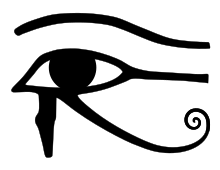
Back Oog van Horus AF عين حورس Arabic عين حورس ARZ Güeyu d'Horus AST Horun gözü AZ হোরাসের চোখ Bengali/Bangla Ull d'Horus Catalan Vedžat Czech Horus' øje Danish Horusauge German

The Eye of Horus, also known as left wedjat eye or udjat eye, specular to the Eye of Ra (right wedjat eye), is a concept and symbol in ancient Egyptian religion that represents well-being, healing, and protection. It derives from the mythical conflict between the god Horus with his rival Set, in which Set tore out or destroyed one or both of Horus's eyes and the eye was subsequently healed or returned to Horus with the assistance of another deity, such as Thoth. Horus subsequently offered the eye to his deceased father Osiris, and its revitalizing power sustained Osiris in the afterlife. The Eye of Horus was thus equated with funerary offerings, as well as with all the offerings given to deities in temple ritual. It could also represent other concepts, such as the moon, whose waxing and waning was likened to the injury and restoration of the eye.
The Eye of Horus symbol, a stylized eye with distinctive markings, was believed to have protective magical power and appeared frequently in ancient Egyptian art. It was one of the most common motifs for amulets, remaining in use from the Old Kingdom (c. 2686–2181 BC) to the Roman period (30 BC – 641 AD). Pairs of Horus eyes were painted on coffins during the First Intermediate Period (c. 2181–2055 BC) and Middle Kingdom (c. 2055–1650 BC). Other contexts where the symbol appeared include on carved stone stelae and on the bows of boats. To some extent the symbol was adopted by the people of regions neighboring Egypt, such as Syria, Canaan, and especially Nubia.
The eye symbol was also rendered as a hieroglyph (𓂀). Egyptologists have long believed that hieroglyphs representing pieces of the symbol stand for fractions in ancient Egyptian mathematics, although this hypothesis has been challenged.[1]
- ^ Ritter (2002), pp. 297–311.